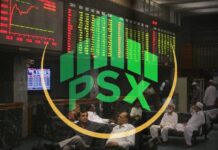SINGAPORE: The dollar hovered near a three-month high on Tuesday as a divided Federal Reserve prompted traders to rein in interest rate cut wagers, while the Australian dollar wobbled after the central bank was cautious about inflation risks.
The Aussie slipped 0.3% immediately after the RBA statement but has since cut losses to where it was before the policy decision and last fetch $0.6529, down 0.17% on the day.
The RBA left its cash rate steady as expected at 3.60%, saying it was cautious about easing further given higher core inflation, firmer consumer demand and a revival in the housing market.
“The statement was not as hawkish as it could have been which put modest downward pressure on AUD/USD,” said Carol Kong, a currency strategist at Commonwealth Bank of Australia.
The RBA now expects underlying inflation- a trimmed mean measure closely watched by the central bank – to accelerate to 3.2% by the end of the year, from the current 3%. That was a sharp upward revision from the previous forecast of a steady 2.6% in coming years.
“Overall, the cautious tone and the updated economic forecasts are consistent with our view that the RBA will remain on-hold from here,” Kong said.
Meanwhile, Fed officials continued offering competing views of where the economy stands and the risks facing it in the absence of economic data suspended due to the federal government shutdown.
The Fed cut rates last week but Chair Jerome Powell suggested that might be the last cut of the year. Traders are now pricing in a 65% chance of a rate cut in December, compared with 94% a week earlier, CME FedWatch showed.
That shift in near-term expectations has boosted the dollar. The euro slipped to three months low of $1.1498 but was last flat at $1.15145, while sterling last fetched $1.312, down 0.13%.
The dollar index , which measures the U.S. currency against six other units, was 0.1% higher at 99.99, at a three-month high.
CBA’s Kong said the differences in opinions among Fed officials suggest a cut in December is not guaranteed.
“Without the release of official U.S. economic data, it is hard to see a further sharp pare back in rate cut pricing and material gains in the USD.”
With government economic data missing due to the second-longest U.S. shutdown, investors this week are eyeing non-government sources of economic data, including ADP employment data, to gauge the health of the U.S. economy.
On Monday, accounts from manufacturers in the Institute for Supply Management survey painted a dire picture of the factory sector, showing U.S. manufacturing contracted for an eighth straight month in October as new orders remained subdued.
“There is no end in sight to the shutdown and the longer this drags on the bigger the economic implication will be,” MUFG strategists said in a note.
“Powell likely wants to avoid appearing as though markets are forcing the Fed to cut. We still argue that the labour market warrants more rate cuts, but the risk is the Fed skips meetings ahead.”
Powell’s hawkish pivot has come at the wrong time for the yen as the Bank of Japan held rates steady last week.
The yen was last flat at 154.11 per U.S. dollar after hitting an eight-and-a-half-month low earlier, leading to some jawboning from Tokyo and stoking intervention jitters.
While Governor Kazuo Ueda last week sent the strongest signal yet that a rate hike was possible as soon as December, markets remained underwhelmed by the central bank’s gradual approach.
The yen is approaching levels at which Japanese authorities intervened in markets in 2022 and 2024 to support the currency.
“Right now, it seems as though the yen is very weak on almost any metric,” said Thomas Mathews, head of markets for Asia Pacific at Capital Economics.
“Investors are also still pricing in some chance of a hike at the next meeting. So, unless the BOJ do tighten policy before the end of the year, and they probably won’t, the most likely path for the yen is even weaker in the near term.”
























